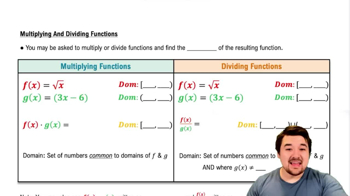Table of contents
- 0. Functions7h 52m
- Introduction to Functions16m
- Piecewise Functions10m
- Properties of Functions9m
- Common Functions1h 8m
- Transformations5m
- Combining Functions27m
- Exponent rules32m
- Exponential Functions28m
- Logarithmic Functions24m
- Properties of Logarithms34m
- Exponential & Logarithmic Equations35m
- Introduction to Trigonometric Functions38m
- Graphs of Trigonometric Functions44m
- Trigonometric Identities47m
- Inverse Trigonometric Functions48m
- 1. Limits and Continuity2h 2m
- 2. Intro to Derivatives1h 33m
- 3. Techniques of Differentiation3h 18m
- 4. Applications of Derivatives2h 38m
- 5. Graphical Applications of Derivatives6h 2m
- 6. Derivatives of Inverse, Exponential, & Logarithmic Functions2h 37m
- 7. Antiderivatives & Indefinite Integrals1h 26m
- 8. Definite Integrals4h 44m
- 9. Graphical Applications of Integrals2h 27m
- 10. Physics Applications of Integrals 2h 22m
4. Applications of Derivatives
Differentials
Problem 64
Textbook Question
Evaluate the following limits. Use l’Hôpital’s Rule when it is convenient and applicable.
lim_x→∞ (x - √(x²+4x))
 Verified step by step guidance
Verified step by step guidance1
Identify the form of the limit as x approaches infinity. The expression x - √(x²+4x) is of the indeterminate form ∞ - ∞.
To resolve the indeterminate form, multiply and divide the expression by the conjugate: (x - √(x²+4x)) * (x + √(x²+4x)) / (x + √(x²+4x)).
Simplify the numerator using the difference of squares: (x² - (x²+4x)) = -4x.
The expression now becomes -4x / (x + √(x²+4x)). Simplify this expression by dividing the numerator and the denominator by x.
Evaluate the limit of the simplified expression as x approaches infinity. The limit of -4 / (1 + √(1 + 4/x)) as x approaches infinity can be found by considering the behavior of each term.
 Verified video answer for a similar problem:
Verified video answer for a similar problem:This video solution was recommended by our tutors as helpful for the problem above
Video duration:
9mPlay a video:
Was this helpful?
Key Concepts
Here are the essential concepts you must grasp in order to answer the question correctly.
Limits
Limits are fundamental concepts in calculus that describe the behavior of a function as its input approaches a certain value. They help in understanding the function's behavior at points where it may not be explicitly defined, such as infinity or points of discontinuity. Evaluating limits is crucial for determining the continuity and differentiability of functions.
Recommended video:

One-Sided Limits
l'Hôpital's Rule
l'Hôpital's Rule is a method used to evaluate limits that result in indeterminate forms, such as 0/0 or ∞/∞. The rule states that if the limit of f(x)/g(x) leads to an indeterminate form, the limit can be found by taking the derivative of the numerator and the derivative of the denominator separately. This process can be repeated if the result remains indeterminate.
Recommended video:
Guided course

Power Rules
Square Root Functions
Square root functions, such as √(x² + 4x), are important in calculus as they often appear in limit problems and can complicate the evaluation of limits. Understanding how to manipulate and simplify expressions involving square roots is essential for applying techniques like l'Hôpital's Rule effectively. Recognizing the behavior of these functions as x approaches infinity is key to solving limit problems.
Recommended video:

Multiplying & Dividing Functions







